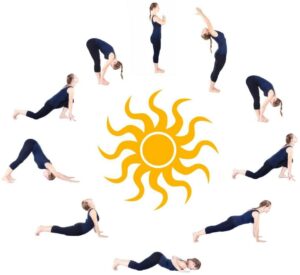Contents
Yoga Asanas For PCOS
Practicing yoga for PCOS is one of the best natural therapies prescribed by experts to treat the syndrome. It strengthens the patients to fight against the odds, like weight gain, hormonal imbalances, and others. In this article, you will find certain poses of yoga for PCOS that can help you fight the symptoms of the syndrome.
So, let’s get started.
Reclining Butterfly Pose (Suptbandhkonasan) for PCOS
Here’s how you do it:

- First, you need to sit on the floor and extend your legs. Bring the soles of your feet together and keep your knees out to the side. Your legs will be shaped like a diamond.
- Lie back on the floor while placing your hands on the belly.
- Take 5 to 10 deep breaths and come back slowly.
- To come out of the posture, give me to roll on your sides using your hands to help you come back to sitting.
There are many benefits of trying this butterfly pose when you are a patient of PCOS. You can see unexpected results within 12 weeks if you practice regularly for 10 minutes. The poster helps stimulate the abdominal organs, like ovaries and urinary bladder. It is also helpful in stretching the muscles of the inner thighs and groin area and also prevents irregular periods and stress.
Sun Salutation (Surya namaskar)
There are twelve prominent poses in Surya Namaskar that can help you fight the signs of PCOS. These poses are as follows:

- Pranamasana (Prayer Pose)
- Hasta Uttanasana (Raised arms pose)
- Hastapadasana (Hand to foot pose)
- Hastapadasana (Hand to foot pose)
- Dandasana (Stick pose)
- Ashtanga Namaskar (salutation with eight parts of the body)
- Bhujangasana (Cobra Asana)
- Adho Mukha Ivana (Downward facing down)
- Ashwa Sanchalanasana (Equestrian Pose)
- Hastapadasana (Hand to foot pose)
- Hasta Uttanasana (Raised arms pose)
- Tadasana
If you practice Sun salutation poses at least five times a day, then there is a scope of looking towards positivity, weight loss, improved lipid profile, achievement of the lower waist to hip ratio, and regulation of the menstrual cycle. It should be a part of your daily life if you are suffering from Irregular periods, PCOS, or PCOD.
Anulom Vilom
Here is how you do it!

You need to begin by sitting down in padmasana, close your eyes, and put your hands on your knees to rest. With the help of your right thumb, you need to block the right nostril of your nose. Slowly inhale and exhale with the left one. Repeat the same process for about 15 minutes with an entire concentration on breathing. Keep changing the nostril to be blocked after fixed intervals of time.
PCOS, being a psychosomatic disorder, needs special psychic and somatic treatments. You can practice Anulom Vilom for at least 10-15 minutes every day to see effective results.
It helps to purify the energy channels inside the body and allows a resistance-free flow of positive energy to provide the relaxation of the mind, soul, and body.
Bow Pose (Dhanurasana)
Here is how you do it.

First, you need to lie down on your belly and place your palms upwards. Now, bend your knees so that your heels come closer to your buttocks. Pull your hands back so that you can touch your ankles and take a hold of them. Now, take a deep breath and lift your heels away from your buttocks. Simultaneously, lift your thighs upwards. Make sure that you keep your back muscles softer. When your belly is pressed against the floor, it will be challenging for you to breathe. Try to breathe more but do not force yourself towards it. Try to hold the pose for the next 20-30 minutes. Release your body as you exhale. Lie down quietly or some time to let your body take a few breaths. Repeat the whole process 2 to 3 three times a day to see the best results.
This asana helps in reducing your stress levels and anxiety. Repetition of this asana three times a day will let you increase the circulation in the pelvic region and help your organs, like neck, back, shoulders, and legs; all at once. It also helps you to get relief at the time of menstrual discomfort.
Do not try this posture if you are suffering from low or high blood pressure, migraine, insomnia, serious lower back, or injury.
Cobra Pose (Bhujangasana)
Here is how you do it.

First, you need to lie down on the floor and stretch your legs backward. The tops of your feet should touch the floor. Spread your hands on the floor, and stretch your elbows back towards the body. Apply force to press the tops of your feet, thighs, and pubis firmly towards the floor. Take a deep breath and begin by straightening your arms and lifting your chest region off the floor. Make sure you go to a height that you can easily attain. Otherwise, you will end up having cramps in the stomach. Afterward, you need to press the tailbone towards the pubis and lift it towards the naval. Do not harden your buttocks, leave them loose. Hold the pose for the next 15-20 seconds, holding the breath simultaneously. Release the pose as you exhale down.
This posture helps you to stretch out the abdominal organs. It also boosts ovarian functions. You may not be able to do the full cobra pose, all at once. But make sure that you do not give up there. Keep practicing and you will reach there one day.
Breathing Exercise (Kapalbhati Pranayam)
To practice this type of yoga to treat PCOS, first, you need to sit comfortably on the floor with your spine erect. Take a deep breath. Pull your navel backward towards your spine, as you exhale. Do this exercise as much comfort as you can. You may keep your right hand on the stomach to feel the abdominal muscles contract. As you relax down, the breath will flow automatically inside your lungs. Once you complete 20 rounds of the process, you will be able to complete one round of Kapal Bhati breathing exercises. You will be able to experience a positive sensation inside your body. If you find yourself comfortable with the posture, do two more rounds of it.
It is a brilliant breathing exercise that helps the patients to fight oxidative stress, problems in the blood circulation, and other issues in glandular secretion. It also helps in weight loss by having a positive influence on the pancreas by regulating its secretion.
These are all the yoga asanas that you can practice at home if you want to treat your PCOS naturally. Make sure that you do not force your body to adapt itself to complete any particular posture of yoga. Do it as much as you can to see the effective results. Know that you will improve with time.
This is everything that you need to know about the yoga and exercises that you can inculcate in the treatment of the syndrome. Know that you facilitate your treatment with both ample exercise and a healthy diet plan.
A Word From Mantra Care
Contact Mantra Care for assistance on PCOS-related problems and their solutions. Their team of experts will be more than happy to help you develop a personalized Women Wellness Program, Online PCOS program that addresses your specific needs.


